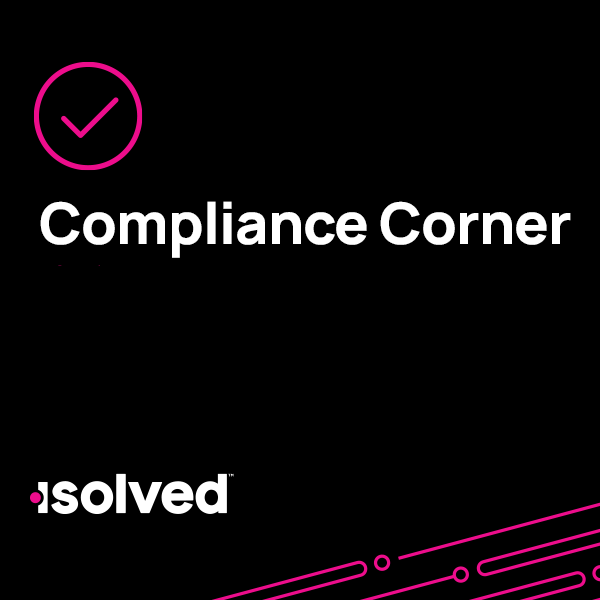Compliance Corner: EEO-1 Compliance-- 6 Things You Need to Know
Tuesday April 30th, 2024
Estimated time to read: 4 minutes, 30 seconds

With a high level of enforcement of workplace discrimination claims, it’s essential to understand what you can do to reduce your exposure. To help ensure compliance with Equal Employment Opportunity (EEO) laws, if you have 100 or more employees, one of the steps your company should take is to file your EEO-1 form every year.
Not only are employers required to keep compliance, but recent changes make it challenging for employers to keep up. Luckily, support is available through expert HR services and technology, including isolved’s Predictive People Analytics™.
Here’s what you need to know about EEO-1 compliance to stay violation-free.
What is Form EEO-1 and what is it used for?
The EEO-1 report collects workforce demographic data from covered employees and is used by the Equal Employment Opportunity Commission (EEOC) to investigate charges of employment discrimination.
Specifically, if your company has 100 or more employees, or you’re a federal contractor with at least 50 employees and $50,000 in contracts, you’ll need to file and certify an EEO-1 form every year. This form details the racial, gender and ethnic makeup of your workforce in Component 1 as well as pay data in Component 2. You can see a sample on the EEOC website.
The data for the period is based on the snapshot period, which is the last quarter of the calendar year, and must include all full-time and part-time employees who were employed during an employer-selected pay period in the fourth quarter. It’s important to note that remote workers must be included in an employer’s EEO-1 report.
The reports must be submitted online via the EEOC’s online filing system. For 2023 data, collection opens April 30, 2024, and closes June 4, 2024.
What organizations/employers are required to fill out an EEO-1 form?
Private employers that have 100 or more employees during a pay period snapshot in the fourth quarter of the reporting year are required to file an EEO-1 report. Although the reporting differs slightly, a multi-establishment company is required to file a separate data record for their headquarters and each individual location, whereas a single establishment employer is only required to submit one EEO-1 Component 1 report.
Additionally, a private employer with fewer than 100 employees must also file an EEO-1 report if the employer is affiliated (i.e., owns, is owned by) with another employer or common control so the businesses represent a single/integrated enterprise and the whole enterprise has more than 100 employees during a pay period snapshot in the fourth quarter.
The Office of Federal Contract Compliance Programs (OFCCP) outlines four criteria regulations that, when met, require a contractor to file EEO-1:
(1) is not exempt from the provisions of these regulations in accordance with § 60-1.5;24;
(2) has 50 or more employees;
(3) is a prime contractor or first tier subcontractor; and
(4) has a contract, subcontract, or purchase order amounting to $50,000 or more or serves as a depository of Government funds in any amount, or is a financial institution which is an issuing and paying agent for U.S. savings bonds and savings notes: Provided, that any subcontractor below the first tier which performs construction work at the site of construction shall be required to file such a report if it meets requirements of (1), (2) and (4).
If an employer meets the EEOC’s filing requirements via the employee threshold and has at least one employee or contractor in the state of California, then they are further subject to California Pay Data Reporting. California law requires private employers of 100 or more employees and/or 100 or more workers hired through labor contractors to annually report pay, demographic, and other workforce data to the Civil Rights Department (CRD). More details are available on the CA Civil Rights Department website.
Have there been recent changes to EEO-1 form reporting?
The EEOC released major EEO-1 form reporting updates in 2024, including a new, non-binary gender option and guidelines for remote workers. Furthermore, the latest EEO-1 form filing requires Unique Entity IDs (UEI) rather than Data Universal Numbering System (DUNS) numbers when reporting for federal contractors.
Due to these updates, there are required changes to the EEOC’s data file upload specifications. You can find the new data file upload specifications here.
Are there any misconceptions about EEO reporting?
One common misconception among employers is that they think they can submit their forms late, after the data collection period closes (at the end of what’s called the “Failure to File” phase). That’s not the case. Employers who fail to submit their EEO-1 report after the grace period ends during any reporting cycle are not permitted to submit such reports during subsequent reporting cycles and will be deemed out of compliance. For example, if you fail to submit a 2023 EEO-1 report, you’re not able to submit that report during the 2024 EEO-1 data collection cycle.
What are the consequences of failing to properly file EEO-1 forms?
There are consequences for both not filing an EEO-1 report or filing one inaccurately.
If you don’t file by the published due date, you’ll receive a “Notice of Failure to File” instructing you to submit your report as soon as possible and no later than the “Failure to File” deadline. If you fail to meet this deadline, then you may be compelled by court order. Federal contractors or subcontractors may have their contracts terminated and be banned from being granted future contracts. For willful errors, employers can face fines and/or imprisonment.
If your company has previously filed an EEO-1 form and no longer meets the reporting eligibility requirements, you should certify that your company is not eligible on the EEOC’s online filing website.
What are the best practices to make sure organizations stay compliant with EEO reporting?
Among other items, employers need to provide the EEOC with employee gender, ethnicity, nationality and race data. This data is collected voluntarily from employees. It is advised that when requesting this information, companies use clear language and be transparent about how data will be used. Demographic information must be stored separately from employee records. If an employee chooses not to disclose, you must still include them in your report; the employer has an obligation to complete the information for them by visual observation.
Assigning employees to EEO-1 job categories is another component of EEO-1 reporting. It is best practice to use the Job Classification Guide to aid in assigning rather than relying on job titles alone. Required skills, training and job responsibilities should be taken into consideration. Employees with dual roles within the company should be assigned to the job that they spend most of their time completing.
Our final tip: keep up to date on requirement changes each year. The EEOC’s dedicated EEO-1 Component 1 website (http:/www.eeocdata.org/eeo1) posts updates, resource material, FAQs and even has a Help Desk.
Do you need help ensuring that your organization is compliant with EEO reporting? Our dedicated team of HR professionals can help.
About Susan Reardon:
Susan Reardon, HR Content Advisor with isolved, is a licensed attorney and communications professional with 20-plus years of experience in HR, insurance and employee benefits.
About Tera Stein:

Tera is an HR Business Partner with isolved and has more than 10 years of experience working in Human Resources including HR compliance, employee benefits and payroll. Tera is a native of California and is accustomed to California law and procedures but has proficiency with HR in all 50 states.
*This blog is not legal advice. Please seek proper legal advice.
